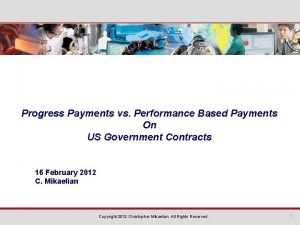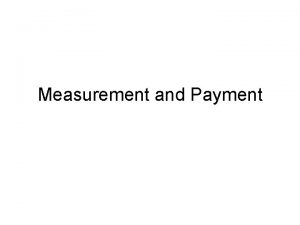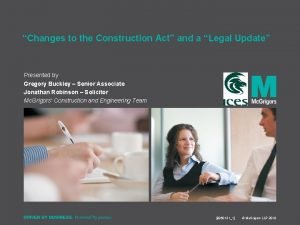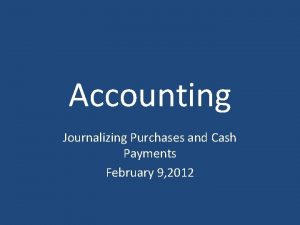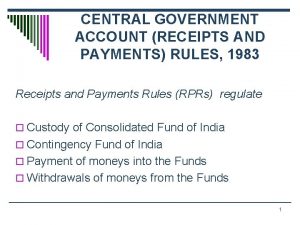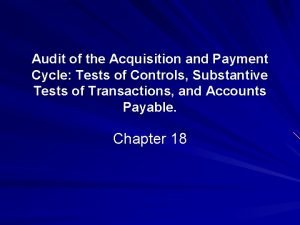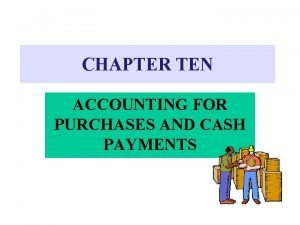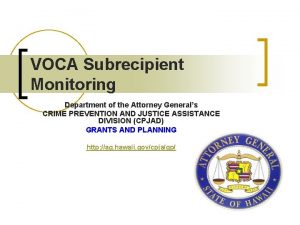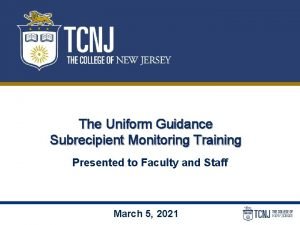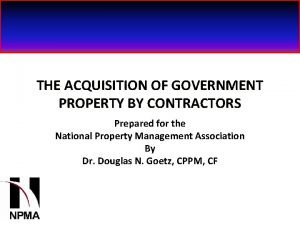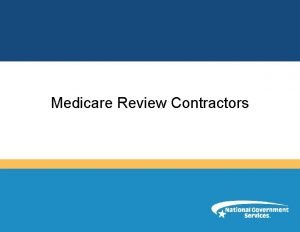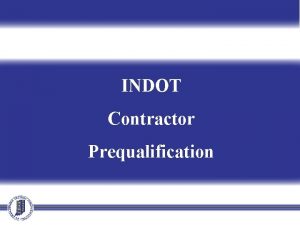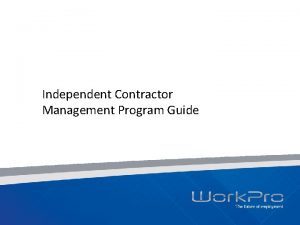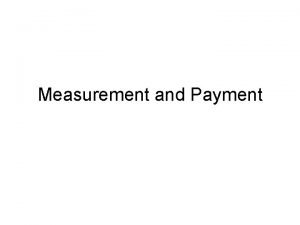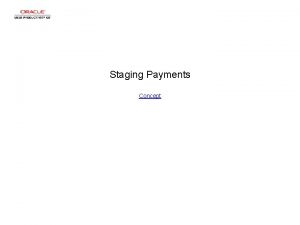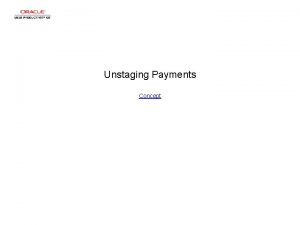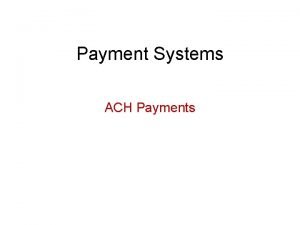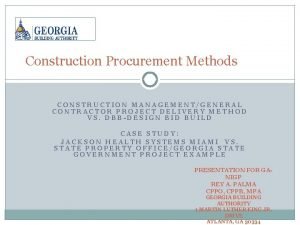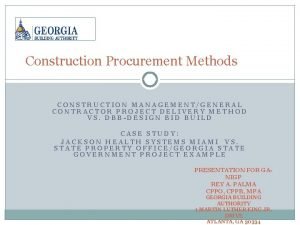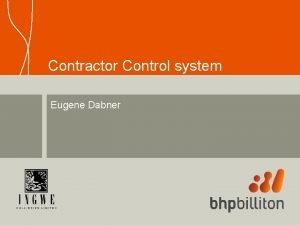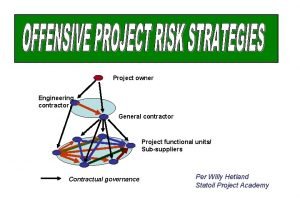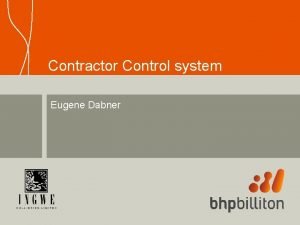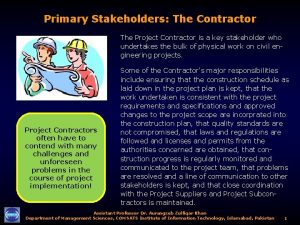Measurement and Payment Construction Progress Payments Contractor gives




























- Slides: 28

Measurement and Payment

• Construction Progress Payments – Contractor gives a bill for progress to RPR • Outlines what bill is for • Give details as needed (quantities) – RPR reviews • Approves (sends to owner) or disapproves (calls contractor) – Contractor gets paid

• Approval of Payment Requests – RPR responsible for checking quantities and costs • Quantity take off • Inventory of equipment and materials on site but not used • Field measure work completed or claimed • Construction Cost Estimate of all completed work • Audit of Invoices and costs • Review of claims for extra work and completed change orders • Check of retention amount • Check method used for profit and overhead, material costs for estra work or change orders

• Basis for Payment Amounts – Accuracy of field measurements determined by contract type – Lump sum contracts do not need accurate field measurements – Cost plus or Unit price contracts need very accurate field measurements • Pg 432

Schedule of Values v. Cost loaded CPM Schedule • Unit Price Contracts – Do not call for Cost Loaded CPM Schedule • Conflicts with line items on unit price sheet – Do not call for schedule of Values – A breakdown of all line items is submitted w/ contractor’s bid and is binding throughout job

• Lump Sum Contracts with Cost Loaded CPM – Do not ask for Schedule of Values – cost loaded CPM is equal – Request Cost loaded CPM be submitted before first pay period ends • Lump Sum Contracts w/o Cost loaded CPM – Do not ask for a cost loaded CPM schedule – Do not ask for a bid breakdown – Request a schedule of values before starting work on project

Evaluation of Contractor’s Payment Requests • Contractor submits request for payment at a prearranged date each month for previous month’s work – Lump sum contract – payment based on a fair estimate of work completed plus overhead and profit – Unit Price Contracts – contractor gets paid based on quantity used – RPR must have accurate field measurements • +/- 25 % is okay more or less allows for renegotiations by either party

• Equipment And Materials delivered but not used – Contractor brings stuff on site early • May try to bill owner since stuff is on site • Contractor only paid when stuff is used • Includes materials used but not completed – pipe not paid for until covered and tested • Unit price contracts are usually for installed in place materials – on site is not in place • Can make exceptions for long lead items which arrive on site early

• Force Account – Daywork or for any type of cost plus payment – In US associated with extra work and change orders – May be used to pay contractor when it is difficult to provide adequate measurements or estimate cost of certain items of work – Should be last choice when setting up items for payment

Force Account – Change order is a must – Force account payments not authorized for supers. Allowances for supers is in contractors O&P. Foremen working full time on item would be covered by account – PM has authority to direct every aspect of force account work

• PM and Contractor must agree on • Labor – Classification and approximate N of workers, wage rates, travel allowance, subsistence, are foremen included • Equipment – Types to be used including size, rating, capacity, which indicate that item can do work required, owned or leased, cost per hour for use • Materials – Cost and freight charges, purchased for project or from contractor’s stock

• PM prepares lists of equipment and labor classifications actually used and corresponding rates – Equipment list includes complete nomenclature of the equipment to establish rental rate from a Rental Rate Book – Labor list includes labor classification and composite hourly rate (basic wage + added costs listed in DOT standard specs)

• Payments for Extra Work and Change Orders – Usually laid out in Contract – Common is cost plus with a reasonable allowance for O&P – State agencies may allow 15, 20, 24, 33 % on labor and then 15% on equipment, 15% on materials 5% on primary subs (not subs)

– RPR must evaluate all change orders and requests for payment of extra work – RPR should consult PM or owner to determine the exact terms of the agreement that cover extra work – RPR keeps daily record of extra work performed and materials used

• Mobilization Costs – Initial expenditures contractor makes before any work towards progress payment – Permits, insurance, bonds – Equipment – Tools and supplies to do work – Field Office • Make it a fixed cost that is on every bid – Contractor cannot inflate

• Make sure that all items allowed in the mobilization cost are listed – Can then either – Prorate mobilization based on % complete – Or Lump sum when all complete • Other items to include – RPR Field Office & Utilities & Communications – Pg 448

Mobilization • Lump Sum Projects – Mobilization terms must be in a separate technical section – Lump sum for mobilization • Unit Price Projects – Part of Measurement and Payment section with a separate line item and an A/E determined cost

Partial Payment to Contractor • Waiver of Lien Procedure – After each progress payment GC, subs, suppliers all sign waivers of liens for that payment – Owner knows subs and suppliers are paid – Limits the amount of the lien to only what has not been paid

• Total Cost Pricing of Change Orders – Compares total cost to do work with bid cost to do work, owner pays difference – Allowed when • Nature of claim makes it v. difficult to establish an accurate price • Contractor’s bid was realistic • Contractor’s costs were realistic • Contractor’s actual costs were realistic • Contractor was not responsible for any of the increased cost

• Forward pricing of Change orders GC and Owner establish a mutually agreed lump sum payment for work Contractor cannot be forced to forward price work Contractor needs to make sure price is right – they are stuck with it

• Retainage – 5 – 10% of contract price – Gives owner $ to satisfy lien claims if GC does not pay – Also is the profit – Can do either a lump sum or it can be computed based on each months progress payments

– Retainage given to GC 35 days after completion of work if – all lien releases turned in – All employees paid – Approval of the performance insurance CO. – GC gets all but the amount representing the value of uncompleted or substandard work or materials.

• Liquidated Damages during construction – Can have liquidated damages for missed milestones • Throws other contractors behind • Deduct from next progress payment

Interpreting the Contractor’s Bid • Bidding Errors – Mathematical errors (unit price x quantity) • Adding up bid items – Ask for values in words and numbers • Words rule – GC may or may not get released from bid

• Unbalanced Bids – Contractor raises prices on some items and lowers prices on others w/o changing total project cost – Should be rejected if found

• Why do unbalanced bids – To discourage certain types of construction and encourage others that the Contractor is good at – Contractor thinks A/E estimate is low can make unit price high and make extra profit – Increase unit prices on first items of work to be completed => receive excessive early payments then default on the job • Leaves Surety with too little $ to do job

• Can build up working capital – eliminates squeeze due to 10% retention • Detecting an Unbalanced Bid – Usually an unbalanced bid indicates and A/E error in estimate – Use a spreadsheet to compare bids to find wide swings in bid prices • All contractor’s should be in the same price range if normal bid

• Resolving an Unbalanced Bid – Easiest way is to reject all bids (owner’s perogative) – Take bids to A/E point out area where possible error exists in estimate – Get a new estimate – Rebid job
 Performance based payment
Performance based payment Progress payments construction
Progress payments construction Physical progress and financial progress
Physical progress and financial progress Progress and performance measurement and evaluation
Progress and performance measurement and evaluation Evaluation in progress
Evaluation in progress Construction act 2011 payment terms
Construction act 2011 payment terms International construction measurement standards
International construction measurement standards Pt georg fischer trading indonesia
Pt georg fischer trading indonesia Contractor compliance and monitoring inc
Contractor compliance and monitoring inc Tyne and wear crushing contractor
Tyne and wear crushing contractor Special amount column definition
Special amount column definition Central government accounts rules 1983
Central government accounts rules 1983 Acquisitions and payments cycle
Acquisitions and payments cycle Capital acquisition and repayment cycle
Capital acquisition and repayment cycle Negotiate with williams and fudge
Negotiate with williams and fudge Accounting for purchases and cash payments
Accounting for purchases and cash payments Subrecipient vs contractor
Subrecipient vs contractor Subrecipient vs contractor
Subrecipient vs contractor Alliant wrap x
Alliant wrap x Milstrip
Milstrip Subrecipient vs contractor
Subrecipient vs contractor Far part 16 source selection
Far part 16 source selection Hard barrication for excavation
Hard barrication for excavation Cpars training slides
Cpars training slides Jessica lunsford badge
Jessica lunsford badge Northeastern unified program integrity contractor
Northeastern unified program integrity contractor Sspc qp 1 contractor list
Sspc qp 1 contractor list Indot prequalified contractors list
Indot prequalified contractors list Independent contractor management system
Independent contractor management system
